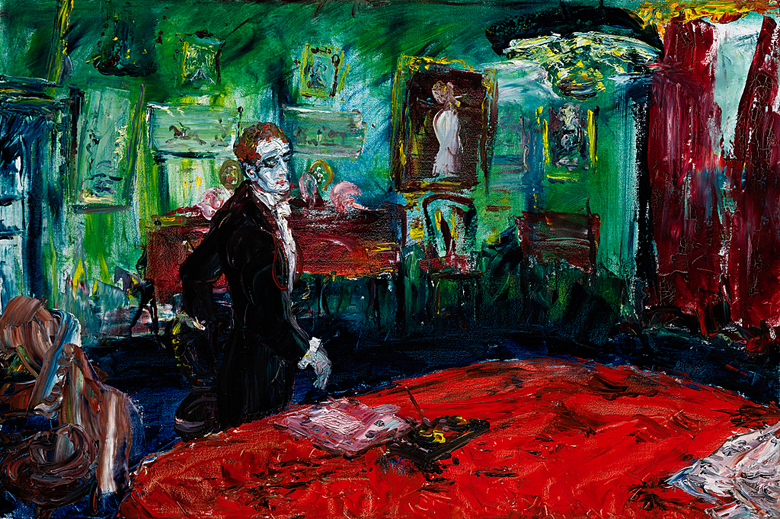 Jack B. Yeats, About to Write a Letter © Estate of Jack B. Yeats, DACS London/IVARO Dublin, 2019. Photo © National Gallery of Ireland
Jack B. Yeats, About to Write a Letter © Estate of Jack B. Yeats, DACS London/IVARO Dublin, 2019. Photo © National Gallery of Ireland

Online self-guided tour
This selection of artworks explores parts of the national collection through a mental health lens. This is designed to allow a closer look at favourite works on display in the Gallery and to encourage dialogue around historical and contemporary mental health issues.
Finding your way around
- If you are doing this tour onsite at the Gallery, taking in all the works will take approximately 60 minutes.
- Feel free to skip a few or spend longer at others.
- When in the Gallery, please be aware that you will be moving across various levels, which may require access to lifts. You can ask any member of staff to direct you to the closest lift.
- They will also be able to direct you to any other facilities you may require including a Changing Places facility located at the Merrion Square entrance.
Some things to consider:
Language
When looking at the treatment of mental health in the past, there are a few issues that we encounter. The first, and often most difficult problem, is that of language. Words used in the past to describe people who had mental health problems are now often deemed insensitive and inappropriate. This is a problem that we will come back to when looking at specific works or people in the collection.
Interpretation
In a historical context, we cannot ascribe or diagnose mental health illnesses to people who are dead, or even to those who are alive but have not been assessed by an accredited professional. Any references to mental health illnesses are based on actual diagnosis or are clearly stated as speculative. At all times the Gallery wishes to be respectfully of people’s personal experiences, living or dead.
Content warning
Some visitors may also find parts of this collection distressing or they may prove an emotional response. We advise that this guide be read with caution. If you are dealing with any mental health issues and need support please consider contacting any of the organisations that we have listed at the end of this resource for assistance.
This tour is presented in tandem with First Fortnight.
Start the tour
 Jack B. Yeats, About to Write a Letter © Estate of Jack B. Yeats, DACS London/IVARO Dublin, 2019. Photo © National Gallery of Ireland
Jack B. Yeats, About to Write a Letter © Estate of Jack B. Yeats, DACS London/IVARO Dublin, 2019. Photo © National Gallery of Ireland
Room 14
Jack B. Yeats (1871–1957), About to Write a Letter, 1935
Yeats’s early work focuses on realistic depictions of his subject matter and shows the influence of his time as an illustrator. However, his later work was influenced by Expressionism, an art movement that often radically distorted realistic forms to evoke a powerful emotional effect.
- What emotions do you feel when looking at this painting?
- What makes you say that?
The political situation in Ireland in the wake of the 1916 Easter Rising, which was of great personal concern to Yeats, served to exacerbate the tension and anxiety from which the artist was already suffering. It may have contributed to the deterioration of his mental state. So low was Yeats’s morale that it prompted serious concern from his father, John Butler Yeats. In a letter to his son in 1916, John voices his concern about Jack’s ‘low spirits’ and fears he may ‘have tumbled into some pits of black melancholy’.
Yeats’s style changed radically in the later 1920s. The artist continued his experiments with colour, producing larger canvases, and his choice of subject matter became more obscure. In light of Yeats’s struggles with mental health and the strong Expressionist influence on his works, About to Write a Letter can be read as an expression of his concerns and anxieties.
- Do you think that there is an anxious atmosphere in this painting?
- What makes you think that? The brushstrokes? The colours? The face of the figure?
Explore further
- Read more about Yeats's painting About to Write a Letter
- Read about Yeats's painting The Liffey Swim
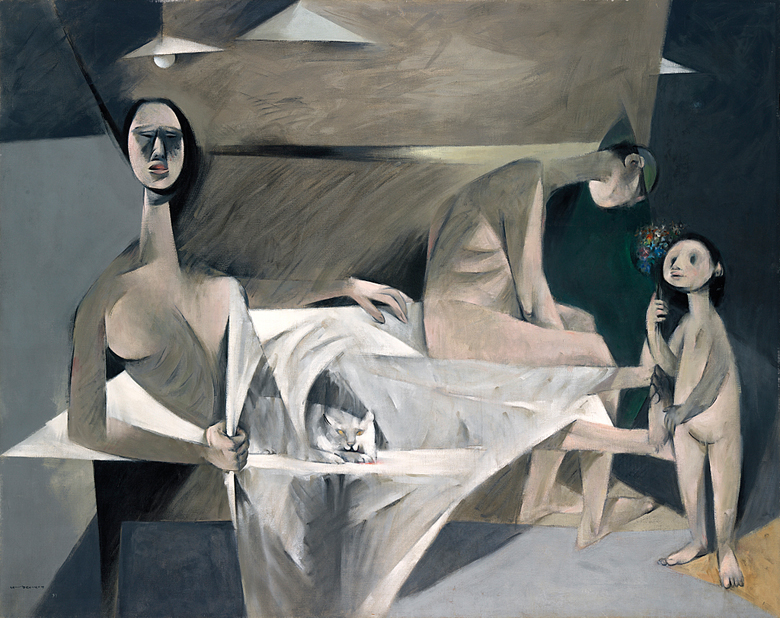 Louis Le Brocquy, A Family © Estate of Louis Le Brocquy. Photo © National Gallery of Ireland
Louis Le Brocquy, A Family © Estate of Louis Le Brocquy. Photo © National Gallery of IrelandRoom 15
Louis le Brocquy (1916–2012), A Family, 1951
- What do you see in this painting?
- How many people are there?
- Where are they?
- What are they feeling?
- What makes you say that?
Louis le Brocquy’s A Family focuses heavily on psychological states. Most notable amongst these is the dejected body language of the father figure on the right, who sits with his back turned to his family. This atmosphere of emotional restraint is reinforced by the surroundings, which resemble a concrete bunker. However, the painting also contains a hopeful message in the form of the young girl and the flowers she carries. The bright bouquet can be read as a symbol of both happiness and hope for the future.
The theme of psychological angst foreshadows Le Brocquy’s own struggles with mental health, which came to the fore in 1963 when he experienced what he described as ‘a very bad year, a blind year.’ Le Brocquy described himself as feeling ‘terribly depressed’ during this time, unable to produce any work of real quality and destroying dozens of the paintings that he produced.
However, it was also during this period that he discovered his inspiration for his famous series of ‘portrait heads’ when his wife, artist Anne Madden, encouraged him to visit Paris. He was greatly moved by the Polynesian artwork he discovered there and this influence led, in part, to some of his most significant artistic achievements.
Explore further
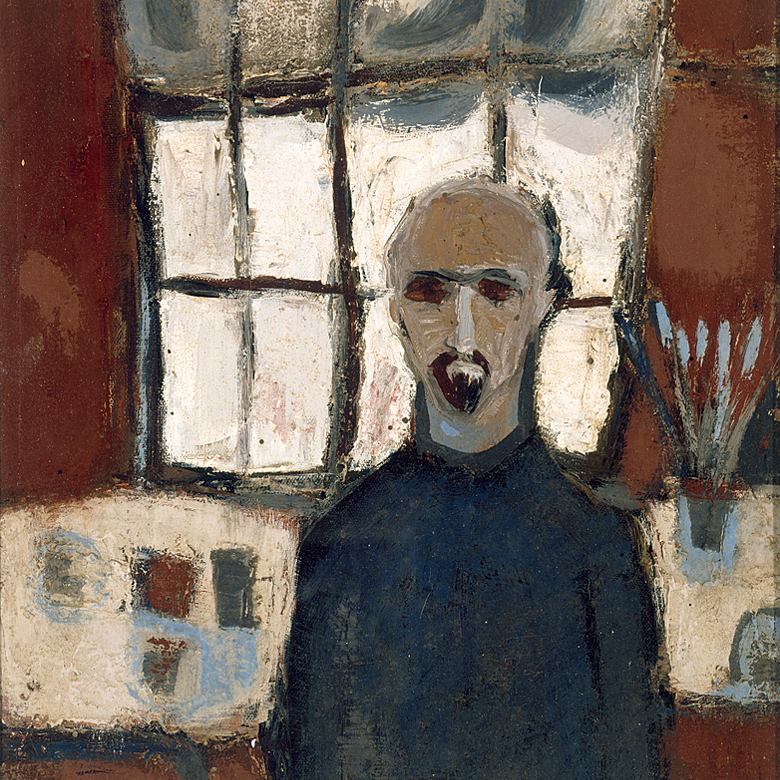 Tony O’Malley, Self-Portrait © The Artist’s Estate. Photo © National Gallery of Ireland
Tony O’Malley, Self-Portrait © The Artist’s Estate. Photo © National Gallery of Ireland
Room 15
Tony O'Malley (1913–2003), Self-Portrait, Winter, Heavy Snowfall at Trevaylor, 1962–63
Tony O’Malley, described as ‘one of the true originals of his time’ by critic Brian Fallon, was a self-taught Irish artist whose work is often a reflection of his own introspective nature. With that in mind, what do you think this self-portrait is saying about his mindset?
O’Malley suffered extensively from both physical and mental ill health during his life. In the late 1950s, when O’Malley was in his mid-40s, his ongoing physical ill health forced his retirement from his job at the Munster and Leinster bank, which he had held for twenty-five years. O’Malley struggled to deal with the loss of routine that followed his departure from the bank, including the social aspect of his life there. His biographer describes O’Malley’s experience after leaving the bank as ‘akin to a nervous breakdown’, one that left the artist finding it ‘very difficult to paint’.
The artist also spoke about how the grief he experienced after the death of his mother, with whom he had a very close relationship and whose portrait he painted on a number of occasions, gave way to a period of mental ill-health which O’Malley described as one of ‘severe depression’. O’Malley recovered from this and, in 1973, married Jane Harris. Throughout the 1970s, the couple spent significant periods in the Bahamas during which he produced some of his most important paintings, which were characterised by their colour and vibrancy.
Explore further
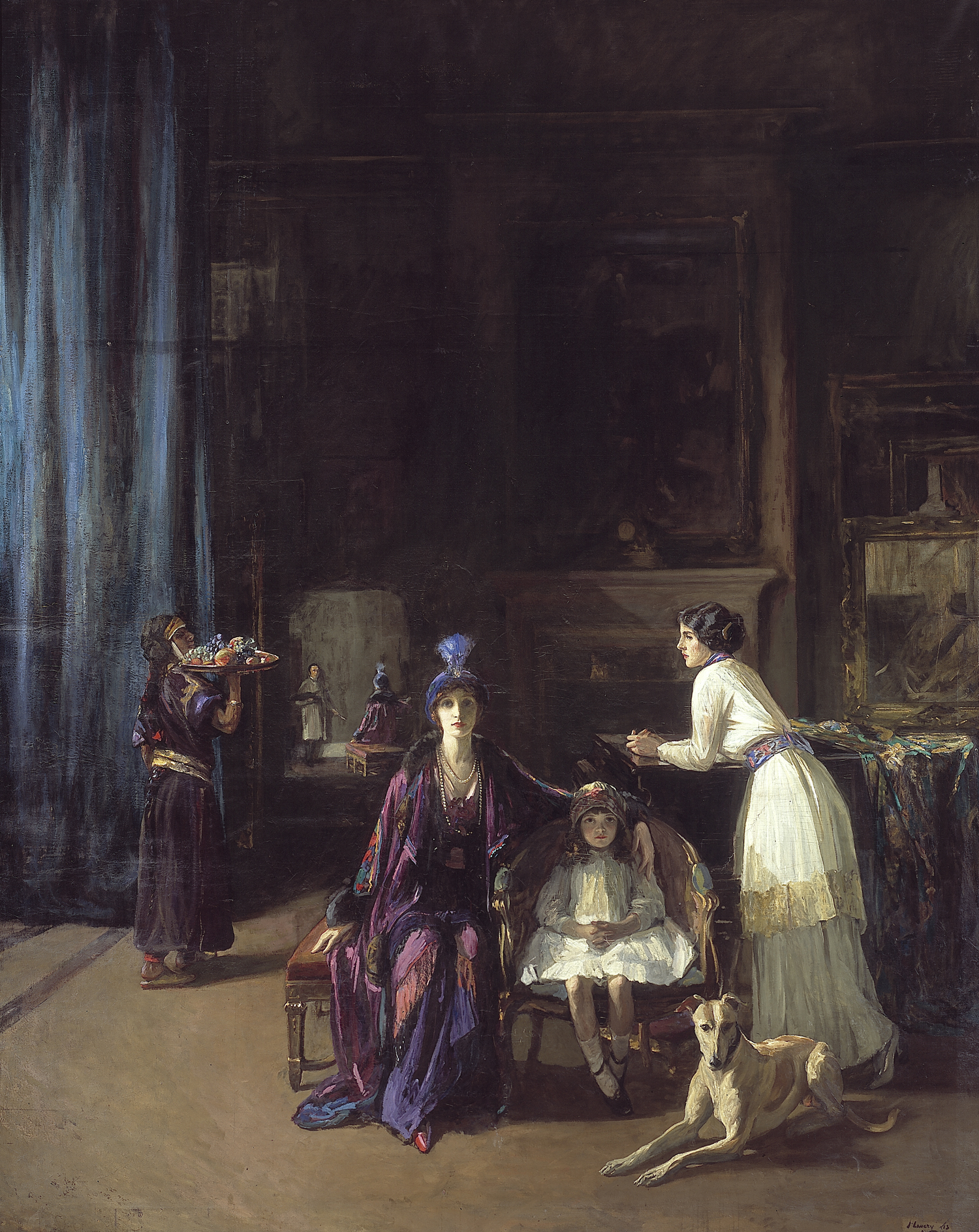 John Lavery (1856-1941), 'The Artist's Studio: Lady Hazel Lavery with her Daughter Alice and Stepdaughter Eileen', 1910-1913. © National Gallery of Ireland.
John Lavery (1856-1941), 'The Artist's Studio: Lady Hazel Lavery with her Daughter Alice and Stepdaughter Eileen', 1910-1913. © National Gallery of Ireland.
Room 16
Sir John Lavery (1856–1941), The Artist's Studio: Lady Hazel Lavery with her Daughter Alice and Stepdaughter Eileen. 1910–13
The main sitter for this painting is the artist’s wife Hazel. She and John Lavery were well known in exclusive social circles in London during the 1910s, and they had contact with some of the most powerful figures in early twentieth-century Britain, including Winston Churchill.
Churchill suffered from bouts of severe depression throughout his life, describing it as his ‘Black Dog’ and was constantly on the lookout for methods to assuage his suffering. One such method, painting, was introduced to him by Hazel Lavery. Churchill discovered this to be an effective antidote to his depression and developed it into a passion that would remain with him throughout his life. He was instructed in his early attempts by Hazel, who taught him the rudiments of technique.
Before long, Churchill was able to join John Lavery in his studio, occasionally painting alongside him. Although not a tremendously gifted artist, Churchill painted hundreds of pictures over his lifetime, including one during World War II, a view of Marrakesh, which he ultimately presented to President Roosevelt.
Do you have a pastime or passion that brings you joy or makes you feel calmer?
Explore further
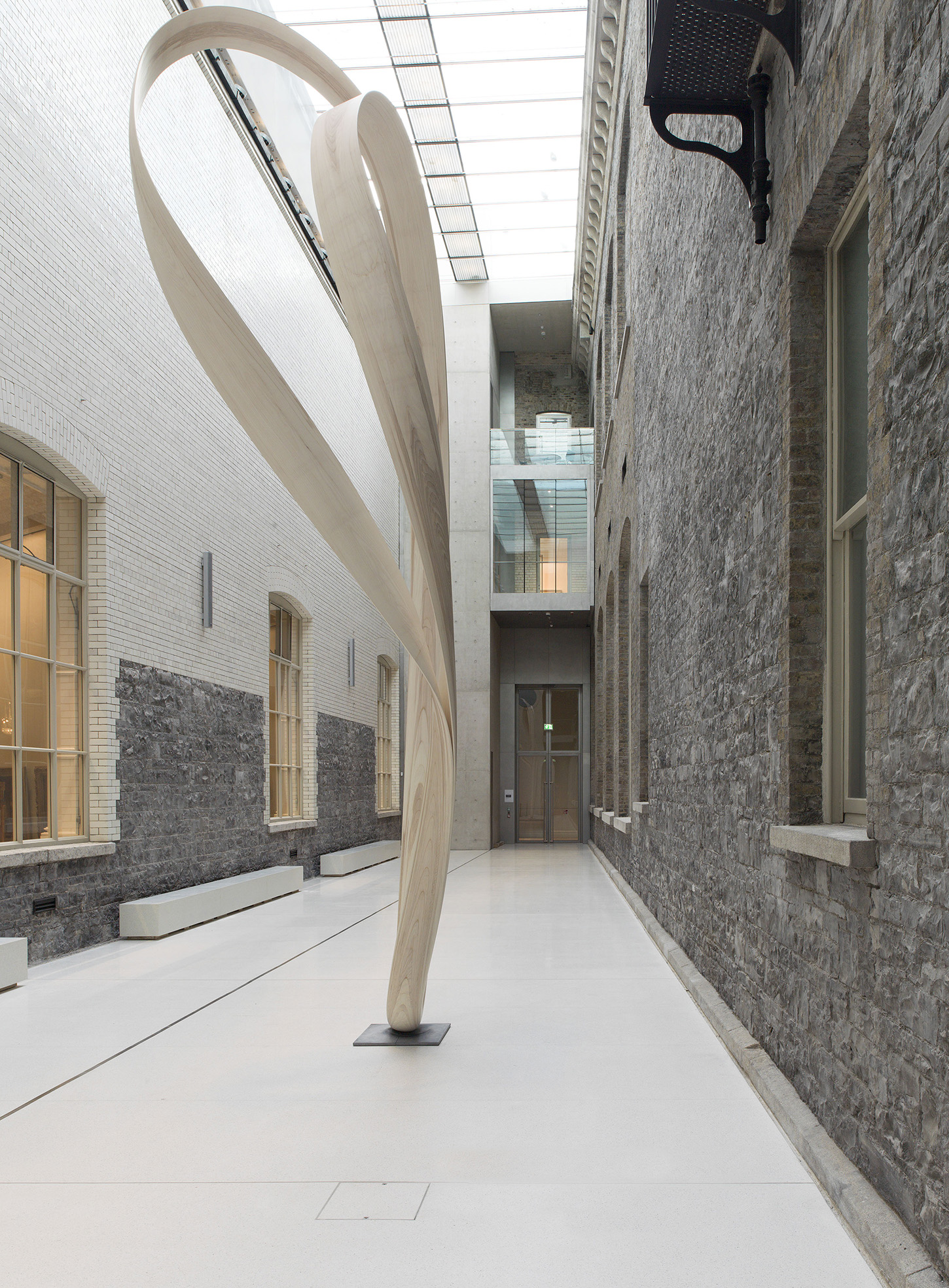
Courtyard
Joseph Walsh (b.1979), Magnus Modus, 2017
Alain De Botton notes that art has a beneficial effect on our psychological wellbeing by helping us develop our sense of self-awareness. He suggests that by paying attention to our response to abstract forms, we can help reveal something about our own tendencies and proclivities. In this way, interacting with art can help to us to understand elusive aspects of our own thinking.
- When you look at Magnus Modus, what do you feel?
- What makes you say that?
Joseph Walsh, an Irish sculptor and furniture-maker, crafted this large free-form sculpture as the third addition to his ‘Magnus’ series which challenges the idea that function demands an explicit use. The abstract nature of this work as well as the range of influences that an artist such as Walsh brings to bear, allows us to explore a huge number of possibilities in the context of our interpretation.
Walsh is influenced by natural elements including local landscapes and rural life. This is reflected in his choice of forms and the tactile nature of his materials and this work introduces a lively, dynamic element into a carefully constructed space.
Explore further
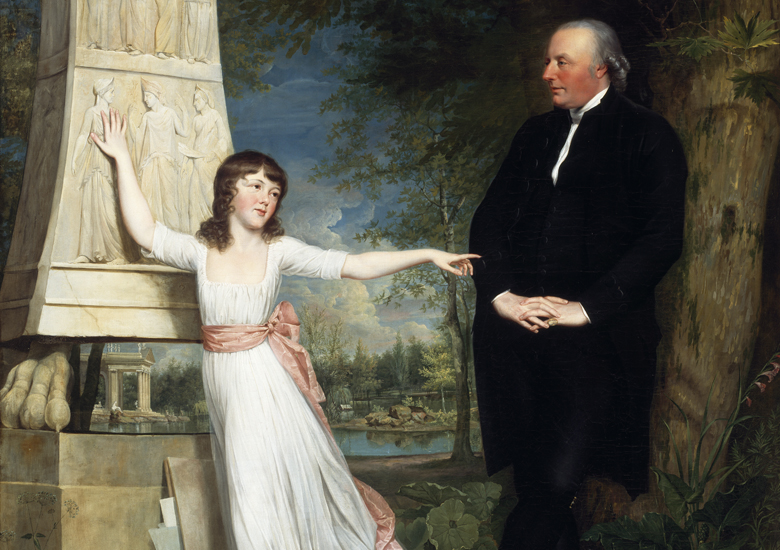 Hugh Douglas Hamilton (1740-1808), Frederick Hervey, Bishop of Derry and 4th Earl of Bristol (1730-1803), with his Granddaughter Lady Caroline Crichton (1779-1856), in the Gardens of the Villa Borghese, Rome, c.1790 - detail.
Hugh Douglas Hamilton (1740-1808), Frederick Hervey, Bishop of Derry and 4th Earl of Bristol (1730-1803), with his Granddaughter Lady Caroline Crichton (1779-1856), in the Gardens of the Villa Borghese, Rome, c.1790 - detail.
Room 21
Hugh Douglas Hamilton (1740–1808), Frederick Hervey, Bishop of Derry and 4th Earl of Bristol (1730–1803), with his Granddaughter Lady Caroline Crichton (1779–1856), in the Gardens of the Villa Borghese, Rome, c.1790
A number of Frederick Augustus Hervey biographers have suggested that the Earl-Bishop suffered from mental illness. In spite of this, Dr Willa Murphy, lecturer in Irish Writing in English at Ulster University, discusses how Hervey is often still characterised as a figure of fun or an ‘eccentric egoist’ to the extent that visitors to his Downhill estate nowadays experience tours which tell of ‘the crazy Earl Bishop who once lived here’.
- How would this label change your view of him?
- How do you think labels effect a person’s place in history?
Murphy notes the danger of such ‘limiting labels’ which she believes have resulted in narrow readings of the life of ‘an expansive, extraordinary figure of the eighteenth century’. She discusses the way in which these labels may have led many to underestimate his character and achievements.
The Earl-Bishop took numerous trips across Europe throughout his life, which Murphy describes as Hervey’s broad-minded attempts to search, in a larger context, for solutions to local political conflicts in Northern Ireland. However, the kind of labels discussed above have often led to these trips being regarded as evidence of ‘a vain, unstable libertine chasing after attention, good food and other people’s wives’.
Interpreting historical stories can be difficult. How might historians view your life in the future?
Explore further
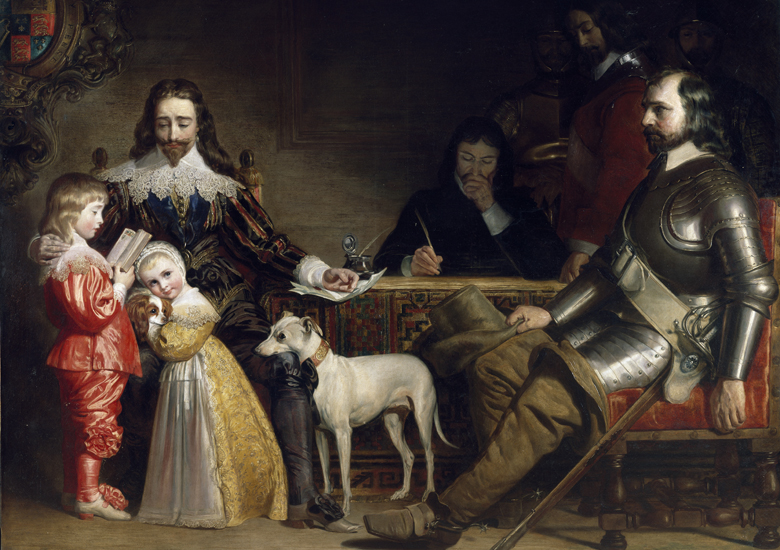 Detail from Daniel Maclise (1816-1870), An Interview between Charles I and Oliver Cromwell, 1836. Photo © National Gallery of Ireland
Detail from Daniel Maclise (1816-1870), An Interview between Charles I and Oliver Cromwell, 1836. Photo © National Gallery of Ireland
Room 46
Daniel Maclise (1806–1870), An Interview between Charles I and Oliver Cromwell, 1836
Oliver Cromwell was an English general and statesman who fought against King Charles I during the English Civil War (1642–1651), which was a war between parliamentarians (those in favour of a parliament ruling England) and royalists (those in favour of an absolute monarchy).
Cromwell’s biographer, Christopher Hill, notes that while Cromwell’s personality was elusive, it seemed to encompass the traits of ‘manic depression’. Bipolar disorder, as it is now more commonly described, is often characterised by a combination of mania, represented by changes in normal mood accompanied by high-energy states, interspersed with depressive episodes.
Cromwell described himself as someone who was both too excessive in his affections and desires, and also often beset by imaginary dangers. Do you get any sense of that from this painting?
Cromwell’s mental illness was diagnosed by a local nineteenth-century doctor as ‘hypochondriasis’, and ascribed to ‘living in low marshy country’. There was also much evidence of his manic states. A number of Cromwell’s associates, including Puritan Church leader Richard Baxter, described some of his behaviour as equivalent to a man who had drunk too much.
Cromwell often displayed the kind of ebullient behaviour associated with manic states, including one incident at the signing of the death warrant for King Charles I, shown on the left of the painting, during which Cromwell and a friend of his began ‘inking one another’s faces like school boys’.
Explore further
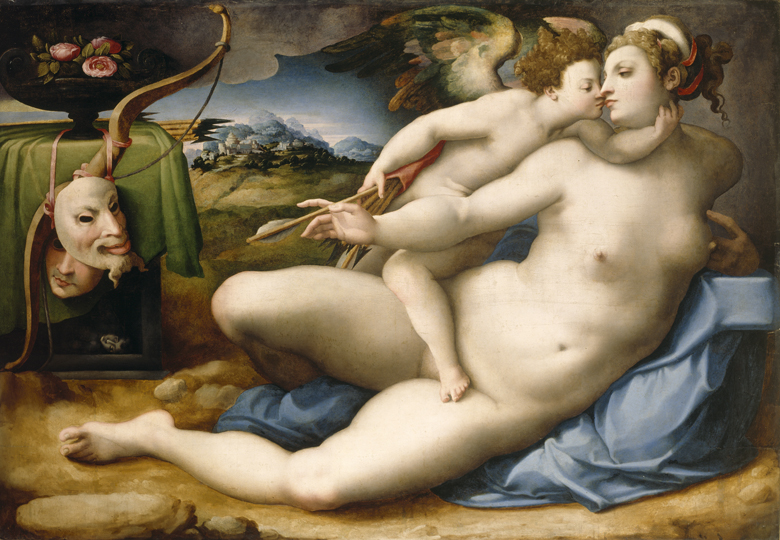 Michele Tosini (1503-1577), after Michelangelo Buonarroti (1475-1564), Venus and Cupid. Photo © National Gallery of Ireland
Michele Tosini (1503-1577), after Michelangelo Buonarroti (1475-1564), Venus and Cupid. Photo © National Gallery of Ireland
This work is not currently on display.
Michele Tosini (1503–1577) after Michelangelo Buonarroti (1457–1564), Venus and Cupid, after 1533
Michele Tosini served as an assistant to Giorgio Vasari, one of the first art historians, who was a friend and biographer of Michelangelo. Through Vasari's example, Tosini produced many works in a style similar to Michelangelo’s and painted some of his best-known works under this influence.
This painting is a copy of an original design by Michelangelo, from 1532, dealing with the relationship between love and deceit. It shows Venus surreptitiously sliding an arrow from Cupid’s quiver while she kisses him.
- What other imagery can you see in this painting?
- What do you think it represents?
Much of Michelangelo’s work is considered to be touched by personal and emotional conflict. Vasari’s contemporaneous biography of Michelangelo, of which the National Gallery of Ireland holds a first edition copy, emphasises much that we would now consider to represent symptoms of depression. These signs are particularly pronounced during Michelangelo's youth and include a lack of appetite and serious sleep disturbance.
In Michelangelo's own diaries, he describes himself as being ‘beset by a thousand anxieties’ and having failed to experience a moment of happiness in 15 years. However, the artist seems, paradoxically, to find a kind of solace in his own suffering, noting that ‘I get my happiness from my own dejection’ in his later poetry. What do you think he meant by that?
Explore further
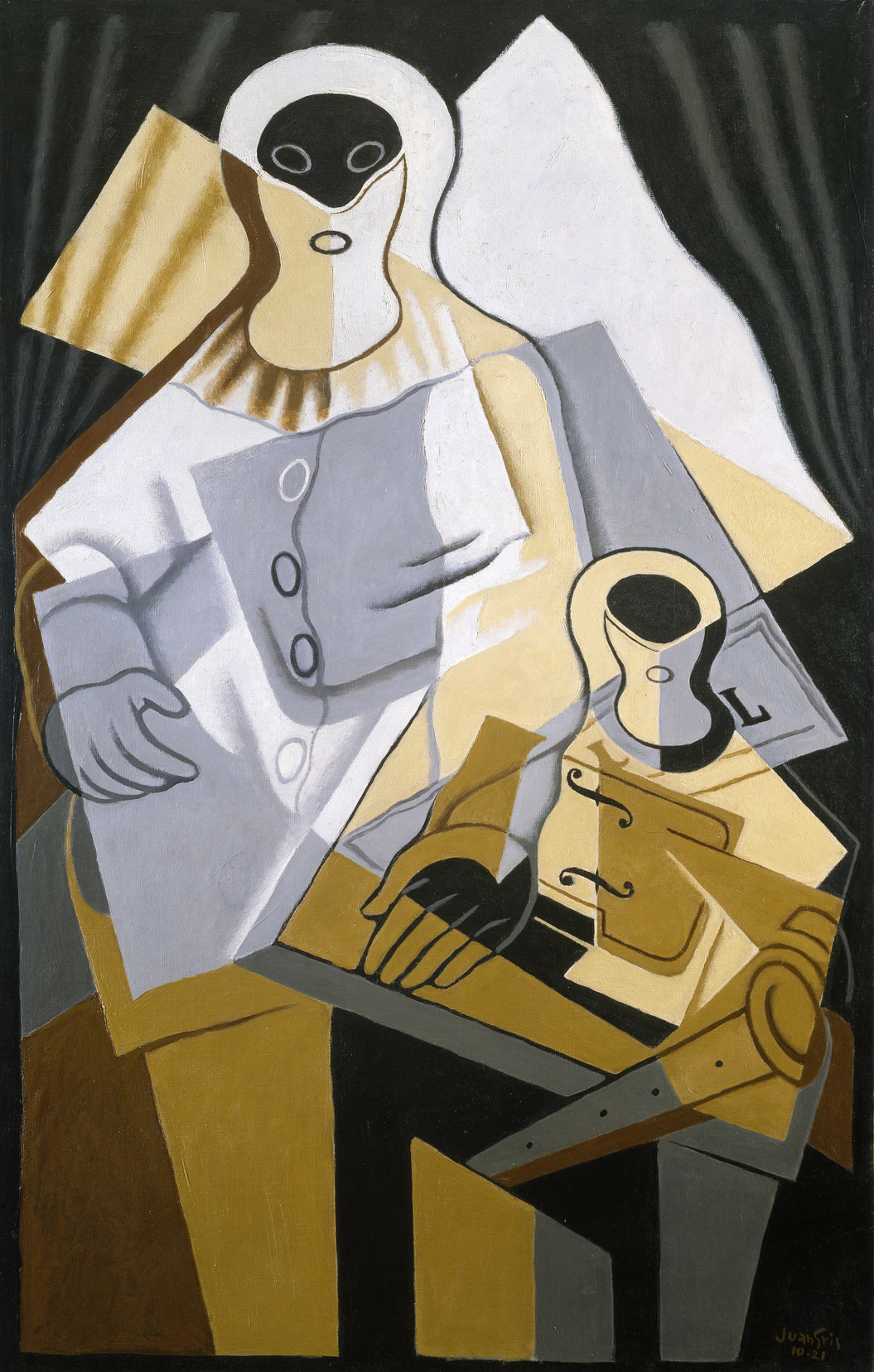 Juan Gris (1887-1927), Pierrot, 1921. Image, National Gallery of Ireland
Juan Gris (1887-1927), Pierrot, 1921. Image, National Gallery of Ireland
Room 5
Juan Gris (1887–1927), Pierrot, 1921
- What do you feel when looking at this painting?
- What makes you say that?
Juan Gris painted Pierrot while recovering from pneumonia in the south of France in 1921. Many Modernist artists related to the figure of Pierrot, the stock pantomime character of a sad clown who suffered from a sense of existential angst, compounded by a string of failed romantic relationships. While Pierrot often represents an alter ego of an alienated artist, there is also a lighter, more playful side to the inclusion of such a buffoonish character.
Juan Gris experienced depression throughout much of his adult life, with individual episodes often lasting from weeks to months. The figure of Pierrot became a prominent theme in the artist’s work from the late 1910s onward, as a means through which Gris expressed his depressed mental state.
The artist experienced the return of his depression after a period of isolation in the early 1920s during which time this painting was made. Although his diaries suggest that this period of solitude initially helped with the production of this work, the depression that this solitude induced ultimately left him unable to complete even a series of smaller paintings.
Explore further
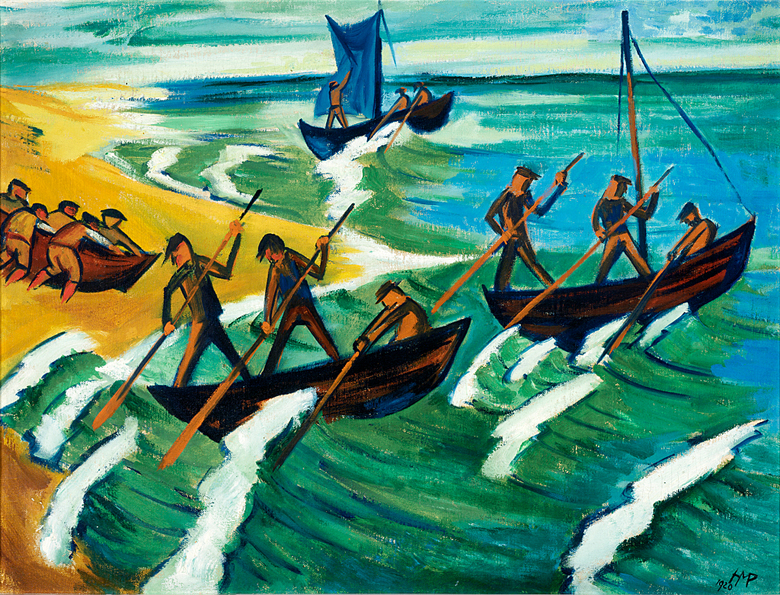 Max Pechstein, Departing Boats (Nidden) © Estate of Max Pechstein, VG Bild-Kunst Bonn/IVARO Dublin, 2019. Photo © National Gallery of Ireland
Max Pechstein, Departing Boats (Nidden) © Estate of Max Pechstein, VG Bild-Kunst Bonn/IVARO Dublin, 2019. Photo © National Gallery of Ireland
Room 5
Max Pechstein (1881–1955), Departing Boats (Nidden), 1920
Max Pechstein endured periods of depression throughout his life. The breakdown of his relationships with his wife Lotte and his art dealer Wolfgang Gurlitt contributed to an episode in the early 1920s.
Pechstein spoke about this to his close friends, often using metaphors of light and darkness to describe his periods of mental suffering. "The sun, for which I had longed so much and which I needed so desperately, remained absent", he reported to a friend in 1922, "I am caught in a dark hole and cannot see an exit".
In turn, Pechstein notes how his depression had an impact on the tone and palette of his paintings, saying "my sadness has resulted in such solemn paintings, I had taken a strong liking to black, but ... would like to flee from it".
- What emotions do you think he was feeling when he painted this work?
- What makes you say that?
However, the artist's biographer Bernhard Fulda notes that his friendships, in particular with Walter Minnich, helped Pechstein deal with his depression, and he greatly looked forward to the prospect of spending time with his closest friends.
This painting, from 1920, represents an idealised vision of communal life in a small fishing village in Denmark, Nidden, which the artist had been visiting and painting since 1909. The setting seems to have represented a kind of escape from everyday life to the artist.
- Do you find comfort in friendships, family or visiting other places?
- Which do find most helpful?
Explore further
Helpful contacts
If you are dealing with any mental health issues and need support please consider contacting any of the organisations listed below for assistance.
- Samaritans: 116 123
- Parentline: 1890 927 277
- GROW: 1890 474 474
- Women’s Aid: 1800 341 900
- CARI: 1890 924 567
- Childline: 1800 666 666
- Dublin Rape Crisis Centre: 1800 778 888
- Teenline: 1800 833 634
- Mens Aid Ireland: (01) 554 3811
- Gay Switchboard Ireland: (01) 872 1055
- Bodywhys: (01) 210 7906
- Aware: 1800 804 848
- Cork Counselling Service: 021 427 4951 / 083 077 7998
- Text About It: TEXT 50808
- Exchange House Ireland National Traveller Mental Health Service: (01) 872 1094
- Helplink: [email protected]
- The Irish Advocacy Network: (01) 445 2350
- Jigsaw: 1800 544 729
- MyMind: 076 680 1060
- Pieta: 1800 247 247 or text HELP to 51444
- The Traveller Counselling Service: (01) 868 5761 or 086 308 1476
Explore more
-

The Liffey Swim: Mindfulness and Art
Video: Spend 3 minutes looking closely at Jack B. Yeats's paintin
-

Opening hours
Open 7 days a week.
-

Podcast | Jack B. Yeats: Painting & Memory
Listen to a new podcast exploring memory in Yeats's work.
-

Through a Lens tour: LGBTQIA+
An online self-guided tour.
